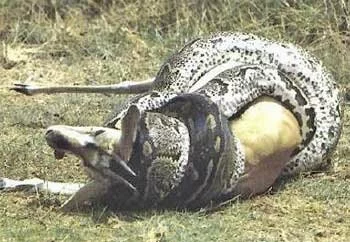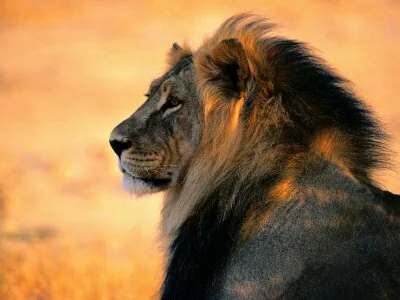Africa is known for being one of the most dangerous places on earth. Its lands are home to some of the most well known predators. For thousands of years, man has struggled to live among the lions, crocodiles, leopards, jackals, snakes, and many other predators which also call this land home. Their cunning and hunting tactics have tested man’s skill, and they continue to serve as symbols of fear, power, death, and sometimes even majesty and courage. Some of these species and their respective traits and abilities will be covered in this article.
The first species that will be covered is Panthera leo, or the lion. Known for its title of “king of the beasts” due to its majestic figure and great mane, the lion is deserving of its title; the male or males of a pride rarely work for their food. It is the females which hunt, and when a kill is made the male will often com in and aggressively take the meal for him. He will rarely share, and even then usually only with cubs. Most of the time, it is only after he has finished his meal that the lionesses can eat. The male’s prominent role is to defend the pride from challengers, usually other male lions who wish to battle the pride’s male for dominance of the females. If another male defeats the pride’s current alpha male, then he will soon kill any cubs to ensure that it is only his genes which are passed on in the pride.
Since they must bring down large prey to feed the pride, lions are very powerful animals. They possess very powerful legs and can reach speeds of about 35 miles per hour. They run down their prey and usually lunge at them when they get close, holding tightly with their sharp claws. When they topple their prey, they normally bite down on the throat, mouth, or nostrils to cause asphyxia. With smaller pray, the lion can simply break the animal’s backbone with a strike from its paws, although the same method as with larger animals may be applied, in which case the prey may die rather quickly due to power of the lion’s jaws crushing down on its neck (lions possess a biting force of around 700 pounds per square inch). The likeliness of lions making kills is only heightened by their cooperation in a pride. Lions will seek out the weakest animals from herds and will focus on hunting only the selected animal once they make their choice. This lowers the risks of injury during a hunt. As a result of these advantages, lions can hunt down many species of animals successfully, making them one of Africa’s apex predators.
Photo Credit: www.africanwildlifepictures.com
Lions are very intelligent and have a strong social bond in their pride. This is unusual for felines, and it may be their social strength that has made them so successful in their habitats. Lions have few natural enemies, and even then, few rivals would dare to take on a whole pride of lions. This makes them one of the most dangerous predators in Africa.
The spotted hyena is known for its ruthless eating behavior; it consumes its prey alive. learnanimals.com
Lions aren’t the only notorious pack hunters in Africa, though. Hyenas have also earned themselves a strong reputation. The species that will be discussed here is the spotted hyena (Crocuta crocuta). By comparison, a hyena is not as deadly as a lion. However, a pack of hyenas can quickly prove dangerous to nearly any animal. When they become aggressive enough, hyenas can drive even small lion prides away from their kills (assuming there are enough hyenas). Hyenas are vicious animals and are known to consume their prey alive. They also possess fairly powerful jaws and will consume the bones of their prey. The hierarchy is very different from lions, with the females having the highest ranks and the males the lowest. Females are about 10% larger than the males. The hierarchy is maintained with aggression, such as biting those lower in the ranks of the pack. Males usually leave the pack at some point, while females remain.[1]
Although certainly not as sophisticated as the lions’ pride, the social lifestyle of hyenas has also made them strong and feared predators. They can become downright vicious when they know they have the advantage in a fight for food, even to lions and leopards. It is this barbaric aggression which has earned them their reputation in a land with many predatory species much larger than them.
The next species is a lone hunter which swallows its prey whole. The African rock python (Python sebae) is one of the largest snakes in the world. It can grow up to 20 feet in length and can tackle prey as large as warthogs and gazelles. However, they’ve been known to attack and kill adults, and on several occasions have eaten children.

The African rock python is a large and powerful constrictor. Photo credit: african-safari-pictures.com
The African rock python is a very aggressive snake compared to other python species. Its readiness to strike and large size make it one of the most dangerous non-venomous snakes. Being a constrictor, it kills by lunging its head at the victim bite on to it with many small razor-like teeth. It then pulls the prey item to its coils (or vice-versa) and wraps the coils around the target. It then begins to apply pressure with its coils. Every time the animal breathes out, the coils tighten. Eventually, the victim cannot take in any more air and dies from suffocation. Sometimes the prey item dies due to the rupturing of its blood vessels from excessive pressure that the snake applies. Since snakes have very flexible lower jaws, the snake can open its mouth widely and work large prey items down its throat (snakes cannot chew).
Pythons eat much less often than other predators. The African rock python species can survive a whole year with just one large meal. Snakes also take a long time to digest food. A large prey item can take a snake anywhere from four days to a week to fully break down. The snake must find a resting place and stay hidden until it has properly digested its food.
Another lone predator is the African leopard (Panthera pardus pardus), the smallest of the four big cats. Although they are much smaller than lions, leopards are no pushovers; they are still very powerful and agile predators which can overpower prey as large as wildebeests.
The African leopard is a beautiful but deadly predator. Photo Credit: african-safari-pictures.com
The African leopard is a muscular animal which also has to run down its prey like the lions and hyenas, only the leopard has to do this alone. But with incredible leg strength and a crushing bite of their own, leopards get by without any need for company. However, leopards are nocturnal hunters. This aids them in making successful kills since it becomes difficult for their prey to see in the dark. Like all felines, the leopard has no difficulty hunting at night. The leopard ambushes its prey and brings it down using its strength and a bite to the throat (much like the lions). In order to avoid competition with other large predators, the leopard may carry its kill up a tree and eat it there without worry of aggressive scavengers.
The final predator that will be covered in this article is Africa’s largest predator and one of the largest reptiles in the world. The Nile crocodile (Crocodylus niloticus) grows to an average of 15-16 feet and can weigh around 600 pounds. However, individuals up to 18 feet long and weighing more than a ton have been recorded. Crocodiles possess the strongest jaws in the animal kingdom, with a bite force of 3000 pounds per square inch. Much of their body is covered in tough armor-like scales to protect them from other crocodiles or other equally threatening animals. Adult Nile crocodiles have no true predators and can prey on almost any animal which travels to the water’s edge for a drink. They submerge themselves underwater and swim closely to one of the animals at the water’s edge. They then swiftly propel themselves out of the water using their tails and bite down on their prey. The prey item is quickly dragged into the water where it is drowned. In the case of large prey which fight back or struggle too much, the crocodile can perform a move known commonly as the “death roll”. When using this, the crocodile bites down tightly into the prey item and quickly rolls its body. This causes massive damage to the victim and usually rips a chunk off of the animal. The weakened animal would usually then either bleed to death, drown, or be killed by the crocodile’s continuing attack or from attacks from other nearby crocodiles.
Nile crocodiles are one of the largest and most powerful crocodilians. © Scotch Macaskill
Crocodiles have been known to compete with lions for food. Being the only species which can actually threaten a lion individually, the confrontations are normally carried out with bluffs and threats. The larger, healthier animal usually gets the remains of the carcass with no actual bloodshed occurring. However, in times of famine, lions and crocodiles have been known to prey on each other. Even then, this is rare. Most of the time, the two species avoid each other.
Africa is home to many fascinating animals, and these predators are but a few of the great number of creatures that we know of. As time goes by we learn more of their lifestyles and tactics. The great variety we see in the animal kingdom is almost unbelievable. These species and many others have a vital role in their environment and in the ecology of Africa. As understood as they sometimes are, their beauty and importance is always there, as they were all given a special purpose when they were created.
[1] Spotted Hyena, www.theanimalfiles.com
2 Responses to Africa’s Crown Predators
Leave a Reply
« At The Riverbank Incognito: Nature’s Hidden Marksman »

Thanks for the post, keep posting stuff
Super